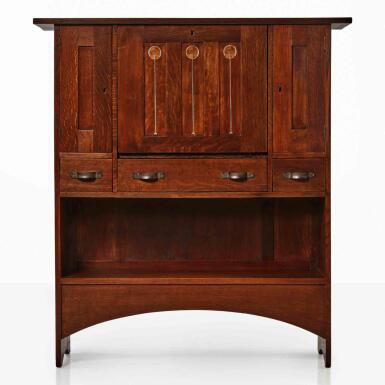
Harvey Ellis
An Important Inlaid Drop-Front Desk
Auction Closed
May 25, 06:32 PM GMT
Estimate
150,000 - 200,000 USD
Lot Details
Description
Harvey Ellis
An Important Inlaid Drop-Front Desk
circa 1903
executed by the Craftsman Workshops of Gustav Stickley, Eastwood, New York
together with an original glass inkwell executed by Steuben Glass Works
oak with copper, pewter and fruitwood inlays and wrought iron hardware
marked with the firm's decal
46 3/8 x 41 7/8 x 11 1/2 in. (117.8 x 106.4 x 29.2 cm)
Acquired from the above by the present owners
Frederick R. Brandt, Late 19th and Early 20th Century Decorative Arts: The Sydney and Frances Lewis Collection in the Virginia Museum of Fine Arts, Richmond, 1985, pp. 120-121
Lisa Phillips and David A. Hanks, High Styles: Twentieth-Century American Design, exh. cat., Whitney Museum of American Art, New York, 1985, p. 17 (for the present lot illustrated)
Stephen Gray, The Early Work of Gustav Stickley, New York, 1987, p. 116
Tod M. Volpe and Beth Cathers, Treasures of the American Arts and Crafts Movement 1890-1920, New York, 1988, p. 32
Janet Kardon, ed., The Ideal Home: The History of Twentieth-Century American Craft 1900-1920, New York, 1993, p. 222
David Cathers, Furniture of the American Arts and Crafts Movement: Furniture Made by Gustav Stickley, L. & J.G. Stickley and the Roycroft Shop, Philmont, NY, 1996, p. 181 (for the model in the collection of the Virginia Museum of Fine Arts, Richmond)
David Cathers and Alexander Vertikoff, Stickley Style: Arts and Crafts Homes in the Craftsman Tradition, New York, 1999, pp. 67 and 92
Karen Livingstone and Linda Parry, eds., International Arts and Crafts, London, 2005, p. 159
Silas Kopf, A Marquetry Odyssey: Historical Objects and Personal Work, New York, 2008, fig. 207
Judith A. Barter, Apostles of Beauty: Arts and Crafts from Britain to Chicago, Chicago, 2009, p. 102
Kevin W. Tucker et al., Gustav Stickley and the American Arts and Crafts Movement, Dallas, 2010, p. 147 (for the model in the collection of the Virginia Museum of Fine Arts, Richmond)
Barry Shifman, Arts & Crafts, Art Nouveau, Art Deco: Selections from the Sydney and Frances Lewis Decorative Arts Galleries at the Virginia Museum of Fine Arts, Richmond, 2015, p. 34 (for the model in the collection of the Virginia Museum of Fine Arts, Richmond)
In the spring of 1903, Gustav Stickley hired a talented architect by the name of Harvey Ellis to execute designs for his Craftsman Workshops in Eastwood, New York. Ellis had garnered success in his hometown of Rochester but had grown dissatisfied with architecture and pursued work in fine arts, illustration and design. Upon joining Stickley, Ellis found his new niche and created a unique series of furniture distinguished by lighter, sophisticated lines and inlaid decoration articulated in copper, pewter and contrasting woods. In January 1904, this series was the subject of an article entitled ''Structure and Ornament in the Craftsman Worskhops'' in Stickley’s magazine, The Craftsman. The article underscored the three formal qualities that made Ellis’ furniture successful: simplicity, lightness and structure. Through its honest construction from high-quality materials, his furniture line also embodied the reform ideals of the American Arts and Crafts movement that Stickley dedicated his career to promoting: “These pieces, in every case, boldly assert the purpose for which they are designed… The principles upon which they are based follow Nature, and must, therefore, be sound and true.”
The drop-front desk presented here perfectly demonstrates these principals. The strong architectonic design of the case, the basic form of which Stickley had conceived for earlier models, is relieved by the slender overhanging cornice at the top as well as the graceful sweeping line of the lower arched apron. The composition of the interior is equally light and functional, offering a series of drawers, shelving compartments and carved slots to hold writing utensils and inkwells. Ornament is reserved solely for the central drop-front panel, which features three delicate flower inlays produced by George Henry Jones’ marquetry workshop in New York City. As poetically described in The Craftsman article, the inlay “bears no trace of having been applied. It consists of fine markings, discs, and other figures of pewter and copper, which, like the stems of plants and obscured, simplified floral forms, seem to pierce the surface of the wood from beneath.” Fruitwood composes the four curved petals and two supporting sepals of each flower, out of which extend two copper anthers. The flower heads are encircled by a ring of pewter, which pops brightly against the rich brown oak surface. Pewter is used again to establish the thin, long stems that accentuate the verticality of the desk. Through the selective addition of this decoration, Ellis astutely alleviated the piece of any heaviness or plainness, and achieved a model that was indeed sound and true.
In the same month of the article touting his achievements and only seven months after joining Stickley’s firm, Ellis died of heart disease, but the designs he created during his short tenure left an enduring legacy on the firm's repertoire. This fall-front desk, other examples of which are in the collections of the Virginia Museum of Art and Art Institute of Chicago, presents a rare opportunity for collectors to acquire an exemplary piece from Ellis’s fleeting but refined career with great significance to the American Arts and Crafts movement.
You May Also Like





